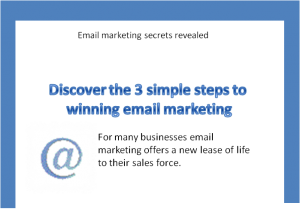Entries Tagged 'email marketing' ↓
June 29th, 2011 — copywriting tips, email copywriting, email marketing
 If your marketing strategy involves email marketing, you would most certainly have experienced some degree of churn.
If your marketing strategy involves email marketing, you would most certainly have experienced some degree of churn.
In a nut shell, churn relates to the number of subscribers lost over a period of time. These would be people who have unsubscribed from your list, emails that have bounced back or spam complaints.
It’s a fact of life and every business will have a churn rate, so you’re not alone.
Although you are unlikely to be able to prevent churn completely, there are steps you can take to reduce it.
1. Honesty is the best policy
Email marketing is all about building relationships. And the strongest relationships are built out of honesty and trust.
So, when you encourage someone to sign up make sure you tell them precisely what they’ll get (nature and frequency of the emails) and stick to it.
If your business offers more than one type of email (especially if you provide products/services to multiple market sectors) a great idea is to set up a preference centre so your subscribers can specify what information they want to receive from you.
Oh, and make sure you tell them about your privacy policy and how you will never pass on their email address to a third party.
2. Easy
Make the whole process easy for them. A simple opt-in and opt-out process is ideal. Although you don’t want to lose them from your list, it’s better to make it easy for them and retain them as a potential future customer than make them jump through hoops and annoy them.
3. Learn
You must remember that you and your employees are only human therefore mistakes will happen. When something goes wrong, or a subscriber simply gets bored of your communications send out a polite, brief email asking them for their opinion on your email marketing. If they respond it could shed some light on why they decided to unsubscribe (e.g. too many, too few, no longer relevant etc.) from your list.
4. Re-engage
This one is for all those inactive subscribers. They are the ones who perhaps immediately delete your email when it arrives or never click on any of the links etc.
Try to temp them back by creating a superb, not to be missed offer.
As you can see, if you engage in email marketing you will experience churn but there are a number of ways you can reduce its effect on your list.
What have your experiences been?
Do you have a high churn rate?
How do you re-engage people?
Please share your experiences by leaving a comment below.
May 25th, 2011 — copywriting tips, email copywriting, email marketing, marketing, proofreading
 We all like to think we’re perfect – but at the end of the day we’re only human which means things go wrong now and then.
We all like to think we’re perfect – but at the end of the day we’re only human which means things go wrong now and then.
Everyone at one time or another has made a mistake.
After spending hours on your latest marketing email, you hit send only to notice at the last minute a blaring typo, you’ve sent it to the wrong list, or you got the offer details wrong.
I can see you’re nodding. But don’t feel bad because you’re not alone – everyone’s been there at some point but its how you deal with it that matters.
How to deal with mistakes
When things go wrong people tend to fall into one of three camps. They either:
- Hide and hope no one notices
- Realise their mistake, correct it and hastily send out the email again to the same list without an apology or explanation
- Hold their hands up to their mistake, apologise and make it up to their customers
Which are you?
By being the honest guy in the third scenario, you’ll gain more respect and happy customers. You’ll probably still get a rap over the knuckles by the boss but at least you owned up and put things right.
Often it’s how companies deal with their mistakes that wins or loses them customers. A company that refuses to acknowledge their short comings will lose customers in spades. But one that admits it’s not always perfect and does get things wrong and is willing to go that extra mile to put it right will retain customers.
How to avoid mistakes
In an ideal world mistakes wouldn’t happen.
Whilst being human tends to mean things will go wrong now and then there are a few simple techniques you can follow to try and keep these cock-ups to a minimum.
1. Validation list
Before you send your email to your customer list, set up a validation list comprising of colleagues or friends (if you’re a one-man/woman band) who will proofread and test out your links for you. This should help flag up any errors before its broadcast.
2. Preview
If you have the ability to preview how your email will look in different browser windows, it will help you ensure your email looks good and that the layout isn’t compromised.
3. Slow down
Don’t leave it to the last minute.
Plan your email marketing carefully to make sure you have plenty of time to compose it and check it before sending it. Writing in haste is asking for trouble.
Email marketing is a very powerful tool when used properly. Whether you create your own content or use a professional copywriter to create it for you, always make sure you check and double check the text, offers and links before sending.
May 18th, 2011 — copywriting tips, email marketing, newsletter, search engine optimisation, seo, website copywriting
 Is yours one of the many businesses out there that sends regular newsletters to your customers?
Is yours one of the many businesses out there that sends regular newsletters to your customers?
You probably spend hours slaving over the content (or get a copywriter to slave away for you) to ensure your message is spot on, you’re offering your readers great information and, of course, the odd offer to encourage them to buy from you.
So what happens once it’s been sent?
If you just broadcast it, forget it and then move on to the next month’s issue you’re missing a HUGE opportunity.
Shall I tell you why?
Using your newsletters to boost your SEO
Let me tell you something about your newsletters.
You already have a strong subject line/header, your content will be SEO friendly (stands to reason as you’re writing about your company, products and services) and it’s original content.
So why not breathe life into your newsletter once it’s been sent rather than forgetting about it?
Placing it within your website will help your SEO no end because you’ll be feeding the Google Monster fresh, original content each and every month – yum.
Of course, you can’t just cut and paste the content into your website; you’ll need to make a few amendments such as:
- Create a new page for each newsletter, so you’ll be treating them like articles.
- Use links within the text (hyperlinks using your keywords) to point to other relevant information within your site or other articles.
- Remove any mentioned of forthcoming events etc. Unlike your newsletter which is transient, your new web page will be around for a long time to come.
- Take out any special offers for subscribers.
- Play around with the layout to make sure it looks attractive. Add sub headings, images and even video to enhance your message.
By repurposing the content in this way you’ll add volume to your website, boost your SEO and offer your readers some great information.
March 30th, 2011 — copywriter, copywriting tips, email copywriting, email marketing, UK copywriter
 If your business is new to email marketing working out how to get people to open your emails can be a real headache.
If your business is new to email marketing working out how to get people to open your emails can be a real headache.
Mind you, you don’t even have to be a newcomer to email marketing to feel the frustration.
The problem is the success of your email all comes down to the recipient, the type of day they are having and the amount of time they have.
Little wonder then why it can seem an up hill struggle to get your emails opened and read.
Improve your email open rates
This is a short list of 5 very simple things you can do to give your email open rate a boost. Some of them may seem obvious but I think it helps every now and then to restate what many people over look.
1. When?
The day on which you send your mail will have a big effect on whether it’s opened or not.
Generally speaking Mondays and Fridays are not good days. On a Monday most people are wading through emails that weren’t cleared the week before, came in over the weekend or they just haven’t gotten into gear yet.
Fridays are bad because people are winding down for the weekend and they don’t have time to read your email.
So, in general, the best days to send are Tuesday, Wednesday or Thursday.
2. Subject line
Subject lines are difficult to write. Not only do they have to grab attention and make the recipient want to open your email, they also have to avoid spam filters.
Including things like ‘discounted offer’ or ‘free product’ or ‘free trial’ will get attention but you must test them to make sure they don’t trip any spam filters.
Another good way of drawing attention to your email is by using your brand name – especially if it’s one the recipient will instantly recognise.
3. How often?
When’s too much or too little?
Getting the frequency right is vital. As a general rule, once a month is ideal. If you bombard your readers with several emails a week they’ll soon get fed up and unsubscribe.
Equally if you send them only once every 6 months or so (or at random intervals) they may forget they’d subscribed in the first place and delete it.
4. List
Your list – who you email to – is vital which is why it’s always best to build your own rather than buy one in.
If someone has signed up for your emails there’s a pretty good chance they want to hear from you. if you buy in a list you are ‘cold emailing’ and they’ll probably end up being deleted.
5. Ask
Sending out emails willy-nilly is fine if you just want to fill them with stuff you want to say. But what about what your reader what’s to hear?
Every so often its good practice to ask them what they want to see so you can be sure the information you are passing to them is what they want to read.
Email marketing is great if you get it right but it takes time to perfect.
Sally Ormond – freelance copywriter
January 26th, 2011 — copywriting tips, email copywriting, email marketing, freelance copywriter, marketing

A new year is a time for resolutions, a lot of which probably only last a few days at most before they are broken.
But just because 2010 is over you shouldn’t just forget about it. Now is a great time to reflect on what happened last year, discover what worked for you and what didn’t. Once you have the answer to those questions you can begin to plan your email marketing strategy for 2011.
Email marketing for 2011
To help you make sure you enjoy successful email marketing campaigns this year I have listed below a few suggestions that might make all the difference.
Now’s the time to try something new to help you enhance your results from last year. So without further ado, here are my suggestions:
1. Remember mobile
One thing many companies forget is how their emails are being read.
More and more people will first become aware of your email on their mobile phone.
How do you decide whether to open and email or not? You probably look at who sent it to you first, followed by the subject line—if it looks interesting you’ll open it. If it doesn’t catch your attention it’ll probably remain unread.
Boost your email’s chances of being read by adding text above your header:

Therefore when the email appear on their phone they will see who it’s from, the subject line and the text ‘Email marketing secrets revealed’.
2. Hook line and sinker
The subject line of your email will ultimately determine whether it is opened or not.
It has to be intriguing, promise something new/important or offer them something that’s going to make their lives easier or help their business.
But once you have them hooked it is just as important to make sure the body of your email provides them with the answers.
Using a strong subject line but then talking about something different in the email will dissolve any confidence they had in you.
Make sure that what your subject line promises, your email delivers.
3. Drop off zone
How long should your email be before your reader dozes off?
An email that goes on and on and on will bore the pants of your recipients so if you have a lot of information you want to get across, add a teaser in the email and then link out to the full article so if they want to learn more, they can.
Everyone is busy and if you constantly send out mind-numbingly long emails you’re going to get a lot of unsubscribers.
4. Call to action
You call to action is vital because it asks your reader to take an action—call you, email you or buy now, book here…
Frequently they are seen as hyperlinked text inviting the reader to click it. But how about using a button instead? It stands out more and there’s something compelling about seeing a button – you just have to press it.
5. Proofread
A simple thing but something that’s not done often enough.
There’s nothing worse than sending out your email only to then discover a prominent typo.
Make sure you speak to your public and not the pubic, offer to nurture your clients but don’t neuter them.
An email full of typos will do untold damage to your reputation, so read it carefully before hitting send.
These 5 simple suggestions could help your 2011 email marketing campaign go with a bang. Try them out and see how you get on.
These tips are brought to you by Sally Ormond, freelance copywriter, blogger and social media fanatic.
 If your marketing strategy involves email marketing, you would most certainly have experienced some degree of churn.
If your marketing strategy involves email marketing, you would most certainly have experienced some degree of churn. We all like to think we’re perfect – but at the end of the day we’re only human which means things go wrong now and then.
We all like to think we’re perfect – but at the end of the day we’re only human which means things go wrong now and then. Is yours one of the many businesses out there that sends regular newsletters to your customers?
Is yours one of the many businesses out there that sends regular newsletters to your customers? If your business is new to
If your business is new to 






